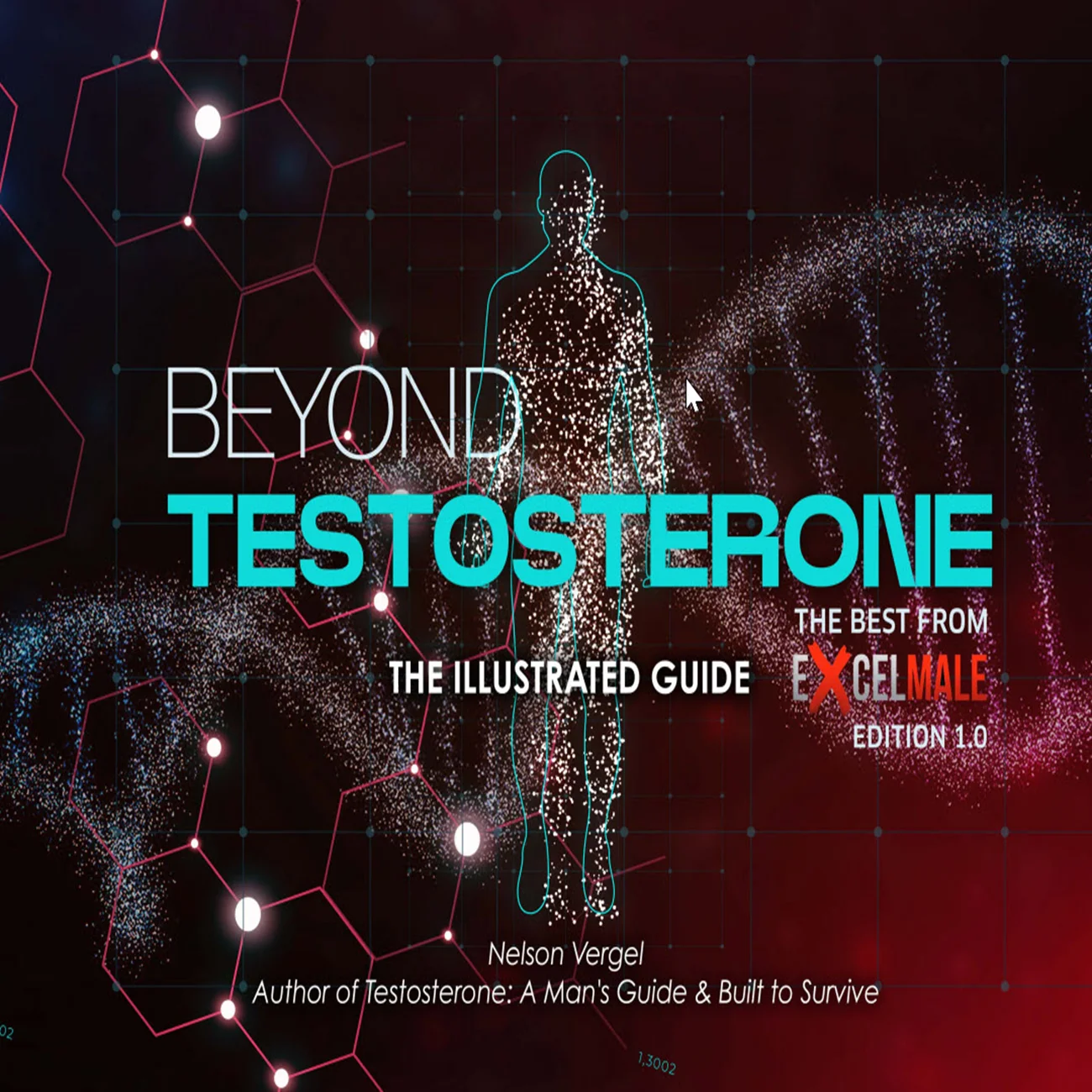Nelson's house u heard it here first!
Dr. Shalender Bhasin!
* over the past 4 decades he has become a global leader in the biology of androgens, sarcopenia and aging related functional decline, his research has shaped clinical guidelines, its informed public health policy particularly around testosterone therapy, anabolic interventions and then the development of function promoting therapies
Pay attention to 25:40-34:36 of the presentation where he explains the importance of measuring free testosterone using a standardized Equilibrium Dialysis method!
Explains the complexity T:SHBG and T:estradiol binding!
* the experimental data does not conform to the linear model (Vermeulen) of testosterones binding and we've shown this also for estradiol, so both for estradiol and testosterone the experimental data do not conform to the linear model, in addition what we have found is that the apparent binding affinity varies dynamically with changes in estradiol and SHBG concentrations
Medical Disclaimer: This article is for informational purposes only and should not replace professional medical advice. Always consult with a qualified healthcare provider before starting any testosterone therapy or making decisions about your health.
Low testosterone isn't what it used to be. Fifty years ago, doctors mainly saw severe cases in young men who never went through puberty properly. Today, the picture looks completely different. Most men dealing with low testosterone are between 40 and 65 years old, carrying extra weight, and managing other health issues like diabetes or heart disease.
Dr. Bhasin, a leading expert from Harvard Medical School who has spent over four decades studying testosterone, explains that this shift has created both opportunities and challenges. While we can now help more men, we also need to be smarter about who truly needs testosterone therapy and who might benefit from other approaches.
Low testosterone (doctors call it hypogonadism) isn't just one simple problem. It's actually a syndrome with two main parts: your body can't make enough testosterone, and you might have trouble making sperm. This affects both your sex life and your ability to have children.
Here's what makes diagnosis tricky: you need both symptoms AND consistently low testosterone levels to confirm the condition. Having just one or the other isn't enough.
The most reliable symptoms include:
The challenge? Many of these symptoms overlap with normal aging, stress, or other health conditions. That's why proper testing is crucial.
Dr. Bhasin describes four common scenarios that show how varied this condition can be:
Case 1: The Young Man Who Never DevelopedA 19-year-old who never went through puberty, has a small penis, small testicles, and can't smell properly. Testing shows extremely low testosterone levels and very low reproductive hormones. This case is straightforward - he clearly needs testosterone replacement.
Case 2: The Cancer SurvivorA 35-year-old man treated for leukemia with chemotherapy and radiation now has fatigue, no sex drive, and erectile problems. His testicles are slightly smaller, testosterone is low, and reproductive hormones are elevated. Again, the diagnosis is clear-cut.
Case 3: The Middle-Aged Man with Multiple Health IssuesA 65-year-old with high blood pressure, type 2 diabetes, and obesity complains of low sex drive, erectile dysfunction, low mood, and tiredness. His testosterone levels are just barely below normal. This is where things get complicated - does he have true low testosterone, or are his other health problems causing the symptoms?
Case 4: The Prostate Cancer SurvivorA 50-year-old who had prostate surgery two years ago for low-grade cancer now has low testosterone levels and bothersome sexual symptoms. His cancer markers look good. The question: Is testosterone therapy safe for him?
These cases show why one-size-fits-all approaches don't work for low testosterone.
Getting an accurate diagnosis isn't as simple as one blood test. Dr. Bhasin explains several factors that make testosterone testing complicated:
Your body doesn't produce the same amount of testosterone all day, every day. Levels are:
This natural variation means a single test might not give the full picture.
Not all testosterone tests are created equal. Different labs use different methods and report different "normal ranges." This has improved recently with standardized testing, but many labs still use outdated reference ranges.
Dr. Bhasin led a major effort to create standardized reference ranges. The research found that the lower limit of normal testosterone is about 263 nanograms per deciliter. Most experts agree that levels below 300 ng/dL typically indicate low testosterone, but there's a gray zone between 200 and 400 ng/dL where diagnosis gets murky.
Here's something that frustrates Dr. Bhasin: Insurance companies often approve testosterone treatment for a man with a level of 299 ng/dL but deny it for someone with 301 ng/dL. This makes no sense scientifically.
Why? Because the test itself has a margin of error of about 15%. Your "true" testosterone level if measured at 300 could actually be anywhere between 210 and 390. That's why doctors need multiple tests over time, not just one number.
Dr. Bhasin recommends a step-by-step approach:
Before diving into testosterone testing, look for common culprits:
For accurate results:
The best test is called liquid chromatography-tandem mass spectrometry (LC-MS). It sounds complicated, but it's simply the most accurate method available.
Most testosterone in your blood is bound to proteins. Only 2-4% is "free" and available for your body to use. If your total testosterone is close to the borderline, measuring free testosterone gives a clearer picture.
This is especially important if you're overweight or have diabetes, because these conditions affect the proteins that bind testosterone.
Once low testosterone is confirmed, doctors need to figure out why. This involves testing other hormones like LH and FSH to determine if the problem is in your testicles or in your brain's hormone control center.
Testosterone was one of the first chemically created drugs available for medical use, synthesized in the 1930s. For decades, it was used mainly for severe cases that were easy to diagnose and treat.
Everything changed in the late 1990s with two developments:
Suddenly, men felt more comfortable discussing sexual health with their doctors. Testosterone sales exploded from $18 million in the early 1990s to over $3.5 billion by 2017.
But this growth came with a problem: many men were being prescribed testosterone therapy without proper diagnosis. The controversy this created led to important research to determine who really benefits from treatment and who doesn't.
Dr. Bhasin led or participated in the largest testosterone research studies ever conducted. Here's what decades of research revealed:
These studies tested testosterone therapy in 780 men aged 65 and older with confirmed low testosterone. The trials lasted one year and examined multiple aspects of health.
Sexual Function Results:
Mood and Energy Results:
Physical Function Results:
This was the game-changer. Dr. Bhasin and his colleague Dr. Lincoff led a study of 5,200 men aged 45-80 with low testosterone and either heart disease or multiple heart disease risk factors. They followed these men for up to five years.
The Good News:
The Concerning Findings:
The Mystery Finding:
Based on all the research, testosterone therapy works best for men who:
Testosterone therapy might not be right if you:
Being overweight doesn't just lower your testosterone through increased body fat. Extra weight causes:
Some overweight men truly have low testosterone. Others have levels that appear low on tests but are actually adequate when free testosterone is measured. This is why accurate testing matters so much.
If you're taking opioid pain medications long-term, they can dramatically suppress your testosterone production. This has become one of the most common causes of low testosterone in younger men today.
The good news? If you can safely stop or reduce opioid use under medical supervision, your testosterone levels often recover.
Men who used anabolic steroids for bodybuilding often develop persistent low testosterone after stopping. The synthetic steroids shut down the body's natural production, and sometimes it doesn't restart properly. These men may need long-term testosterone replacement.
If you and your doctor decide testosterone therapy is right for you, several options exist:
These are applied to your skin daily, usually on the shoulders, arms, or abdomen.
Pros:
Cons:
These are given into muscle, typically every 1-2 weeks.
Pros:
Cons:
Dr. Bhasin notes that injection doses are often higher than necessary. Many men do well with lower, more frequent doses that keep levels steadier.
Starting testosterone therapy isn't a "set it and forget it" situation. Regular monitoring is crucial for safety and effectiveness.
Within the first few months:
Every 6-12 months:
Testosterone stimulates red blood cell production. While moderate increases are normal and even beneficial (especially if you were anemic), excessive increases can be dangerous.
The good news from Dr. Bhasin's research: When testosterone is dosed properly to keep levels in the normal range and monitored carefully, dangerous red blood cell elevations are rare. In the TRAVERSE trial with over 5,000 men, only 3-4 had to stop testosterone due to this issue.
One of the most surprising findings from the TRAVERSE trial was how rare prostate problems were. In men carefully selected and monitored:
This doesn't mean testosterone is completely safe for the prostate, but it's much safer than previously feared when used appropriately.
Dr. Bhasin emphasizes that unlike life-threatening conditions, low testosterone isn't going to kill you. This means there's time to make thoughtful, individualized decisions.
Consider testosterone replacement if you:
Try other approaches before testosterone if:
After reviewing decades of research and treating thousands of patients, Dr. Bhasin's message is clear: testosterone therapy can be beneficial for the right men, but it's not a miracle cure for aging or a substitute for healthy lifestyle choices.
The key points every man should know:
About Diagnosis:
About Benefits:
About Risks:
About Treatment Decisions:
If you're experiencing symptoms that might be related to low testosterone, here's what to do:
Remember, low testosterone is common, treatable, and nothing to be embarrassed about. With proper diagnosis and treatment when appropriate, many men see significant improvements in their quality of life.
Don't let symptoms of low testosterone control your life. Whether you're dealing with reduced sex drive, constant fatigue, or other concerning symptoms, getting an accurate diagnosis is the first step toward feeling like yourself again.
Ready to take action? Schedule a consultation with a qualified men's health specialist who can properly evaluate your testosterone levels and help determine the best treatment approach for your individual situation. With the right guidance and monitoring, you can make informed decisions about your health and well-being.
Final Medical Disclaimer: This article provides general information about low testosterone based on current medical research and expert opinion. It is not a substitute for personalized medical advice from a qualified healthcare provider. Testosterone therapy carries both benefits and risks that vary by individual. Always consult with a licensed physician before starting, stopping, or changing any medical treatment. The information presented here is current as of the date of publication but medical recommendations may change as new research becomes available.

25:40-34:36
Methods for Assessing Free Testosterone (FT) Levels

Implications of the Inter-monomeric Allostery and Dynamic Changes in Binding Affinity of SHBG and Albumin

Huge contribution to the field and has been working behind the scenes with the CDC on a standardized ED procedure/assay and harmonized reference range for free testosterone!
As of now there is no commercially available standardized ED procedure/asay or a harmonized reference range for FT!
Been waiting on this for years, looking forward to putting an end to this free T s**t show!
Pay attention to 25:40-34:36 of the presentation where he explains the importance of measuring free testosterone using a standardized Equilibrium Dialysis method!
This is what is coming!
Remember what I have been stressing over the years that not all ED devices/procedures are the same!
Interesting that he is still pushing the ensemble allosteric model (EAM) according to Zakharov (cFT-Z) the calculated Tru-T algorithm.
I will be waiting on the new data/validation before jumping the gun here!
This is where it stands as of now!
Bhasin and his team are still active with Phase IIB: Development of TruT Algorithm for Commercializations in Androgen Disorders!
Project end date: 31-August-2026
My reply:
Even then Quest''s ED assay is not the same as the ED assay used in the Jasuja/Bhasin paper that I posted back in 2022 before it was released.
The reference ranges given in that paper only apply to that specific assay (ED device/procedure).
The reference ranges in that paper are not set in stone!
As of now there is no standardized ED procedure/assay or harmonized reference range for free testosterone!
Also need to understand that when it comes to the confusion of the currently used/relied upon ED methods between laboratories for testing free testosterone everyone needs to keep in mind that not all ED devices/procedures are the same.
Dr. Shalender Bhasin!
* over the past 4 decades he has become a global leader in the biology of androgens, sarcopenia and aging related functional decline, his research has shaped clinical guidelines, its informed public health policy particularly around testosterone therapy, anabolic interventions and then the development of function promoting therapies
Pay attention to 25:40-34:36 of the presentation where he explains the importance of measuring free testosterone using a standardized Equilibrium Dialysis method!
Explains the complexity T:SHBG and T:estradiol binding!
* the experimental data does not conform to the linear model (Vermeulen) of testosterones binding and we've shown this also for estradiol, so both for estradiol and testosterone the experimental data do not conform to the linear model, in addition what we have found is that the apparent binding affinity varies dynamically with changes in estradiol and SHBG concentrations
The Complete Guide to Low Testosterone: What Every Man Should Know About Diagnosis and Treatment
Medical Disclaimer: This article is for informational purposes only and should not replace professional medical advice. Always consult with a qualified healthcare provider before starting any testosterone therapy or making decisions about your health.
Understanding Low Testosterone in Today's World
Low testosterone isn't what it used to be. Fifty years ago, doctors mainly saw severe cases in young men who never went through puberty properly. Today, the picture looks completely different. Most men dealing with low testosterone are between 40 and 65 years old, carrying extra weight, and managing other health issues like diabetes or heart disease.
Dr. Bhasin, a leading expert from Harvard Medical School who has spent over four decades studying testosterone, explains that this shift has created both opportunities and challenges. While we can now help more men, we also need to be smarter about who truly needs testosterone therapy and who might benefit from other approaches.
What Exactly Is Low Testosterone?
Low testosterone (doctors call it hypogonadism) isn't just one simple problem. It's actually a syndrome with two main parts: your body can't make enough testosterone, and you might have trouble making sperm. This affects both your sex life and your ability to have children.
Here's what makes diagnosis tricky: you need both symptoms AND consistently low testosterone levels to confirm the condition. Having just one or the other isn't enough.
Common Signs You Might Have Low Testosterone
The most reliable symptoms include:
- Reduced sex drive - This is the strongest indicator
- Erectile dysfunction - Though this can have many causes
- Extreme fatigue - Feeling wiped out even after rest
- Loss of body hair - Particularly noticeable changes
- Smaller testicles - A physical sign doctors check for
- Tender breast tissue - Called gynecomastia in medical terms
- Low mood and energy - Feeling down or unmotivated
The challenge? Many of these symptoms overlap with normal aging, stress, or other health conditions. That's why proper testing is crucial.
The Four Different Types of Low Testosterone Cases
Dr. Bhasin describes four common scenarios that show how varied this condition can be:
Case 1: The Young Man Who Never DevelopedA 19-year-old who never went through puberty, has a small penis, small testicles, and can't smell properly. Testing shows extremely low testosterone levels and very low reproductive hormones. This case is straightforward - he clearly needs testosterone replacement.
Case 2: The Cancer SurvivorA 35-year-old man treated for leukemia with chemotherapy and radiation now has fatigue, no sex drive, and erectile problems. His testicles are slightly smaller, testosterone is low, and reproductive hormones are elevated. Again, the diagnosis is clear-cut.
Case 3: The Middle-Aged Man with Multiple Health IssuesA 65-year-old with high blood pressure, type 2 diabetes, and obesity complains of low sex drive, erectile dysfunction, low mood, and tiredness. His testosterone levels are just barely below normal. This is where things get complicated - does he have true low testosterone, or are his other health problems causing the symptoms?
Case 4: The Prostate Cancer SurvivorA 50-year-old who had prostate surgery two years ago for low-grade cancer now has low testosterone levels and bothersome sexual symptoms. His cancer markers look good. The question: Is testosterone therapy safe for him?
These cases show why one-size-fits-all approaches don't work for low testosterone.
Why Testing for Low Testosterone Can Be Tricky
Getting an accurate diagnosis isn't as simple as one blood test. Dr. Bhasin explains several factors that make testosterone testing complicated:
Your Testosterone Levels Change Constantly
Your body doesn't produce the same amount of testosterone all day, every day. Levels are:
- Higher in the morning than evening
- Higher at the end of winter than end of summer
- Released in pulses every 90-120 minutes throughout the day
- Different from one day to the next
This natural variation means a single test might not give the full picture.
Lab Tests Aren't Always Accurate
Not all testosterone tests are created equal. Different labs use different methods and report different "normal ranges." This has improved recently with standardized testing, but many labs still use outdated reference ranges.
Dr. Bhasin led a major effort to create standardized reference ranges. The research found that the lower limit of normal testosterone is about 263 nanograms per deciliter. Most experts agree that levels below 300 ng/dL typically indicate low testosterone, but there's a gray zone between 200 and 400 ng/dL where diagnosis gets murky.
The Insurance Company Insanity
Here's something that frustrates Dr. Bhasin: Insurance companies often approve testosterone treatment for a man with a level of 299 ng/dL but deny it for someone with 301 ng/dL. This makes no sense scientifically.
Why? Because the test itself has a margin of error of about 15%. Your "true" testosterone level if measured at 300 could actually be anywhere between 210 and 390. That's why doctors need multiple tests over time, not just one number.
Getting an Accurate Diagnosis: The Right Way
Dr. Bhasin recommends a step-by-step approach:
Step 1: Check for Obvious Causes First
Before diving into testosterone testing, look for common culprits:
- Opioid pain medications - These are now the most common cause of low testosterone in younger men
- Anabolic steroid use - Even after stopping, levels can stay low
- Certain medications - Including some for depression and blood pressure
Step 2: Get Proper Blood Tests
For accurate results:
- Test in the morning (testosterone is highest then)
- Don't eat before the test
- Don't test when you're sick
- Use a reputable lab certified by the CDC
- Get tested more than once to confirm
The best test is called liquid chromatography-tandem mass spectrometry (LC-MS). It sounds complicated, but it's simply the most accurate method available.
Step 3: Measure Free Testosterone If Needed
Most testosterone in your blood is bound to proteins. Only 2-4% is "free" and available for your body to use. If your total testosterone is close to the borderline, measuring free testosterone gives a clearer picture.
This is especially important if you're overweight or have diabetes, because these conditions affect the proteins that bind testosterone.
Step 4: Find the Root Cause
Once low testosterone is confirmed, doctors need to figure out why. This involves testing other hormones like LH and FSH to determine if the problem is in your testicles or in your brain's hormone control center.
The Evolution of Testosterone Therapy
Testosterone was one of the first chemically created drugs available for medical use, synthesized in the 1930s. For decades, it was used mainly for severe cases that were easy to diagnose and treat.
Everything changed in the late 1990s with two developments:
- Viagra became available for erectile dysfunction
- Easy-to-use testosterone gels hit the market
Suddenly, men felt more comfortable discussing sexual health with their doctors. Testosterone sales exploded from $18 million in the early 1990s to over $3.5 billion by 2017.
But this growth came with a problem: many men were being prescribed testosterone therapy without proper diagnosis. The controversy this created led to important research to determine who really benefits from treatment and who doesn't.
What the Major Research Studies Found
Dr. Bhasin led or participated in the largest testosterone research studies ever conducted. Here's what decades of research revealed:
The T Trials (Testosterone Trials)
These studies tested testosterone therapy in 780 men aged 65 and older with confirmed low testosterone. The trials lasted one year and examined multiple aspects of health.
Sexual Function Results:
- Strong improvement in overall sexual activity
- Significant increase in sex drive
- Relief from low testosterone symptoms
- Small, inconsistent effects on erectile function
- No improvement in men with normal testosterone levels
Mood and Energy Results:
- Improved mood in men with mild to moderate depression
- Increased energy levels
- Did NOT help men with severe clinical depression
- Testosterone is not a treatment for depression
Physical Function Results:
- Increased lean muscle mass
- Improved leg press strength and power
- Better stair climbing ability
- Increased aerobic capacity
The TRAVERSE Trial: The Big Safety Study
This was the game-changer. Dr. Bhasin and his colleague Dr. Lincoff led a study of 5,200 men aged 45-80 with low testosterone and either heart disease or multiple heart disease risk factors. They followed these men for up to five years.
The Good News:
- Testosterone therapy was as safe as placebo for heart attacks, strokes, and cardiovascular death
- Very few prostate problems occurred
- Anemia improved in men who had it
- When testosterone levels were carefully monitored, dangerous red blood cell increases were rare
The Concerning Findings:
- Higher risk of blood clots in veins (pulmonary embolism)
- More cases of atrial fibrillation (irregular heartbeat)
- Increased acute kidney injury
- Surprisingly, more bone fractures (possibly because men became more active)
The Mystery Finding:
- The increased blood clot risk wasn't related to red blood cell count as expected
- Instead, it appeared connected to increases in white blood cells (neutrophils and monocytes)
- This suggests inflammation plays a role
Who Benefits Most from Testosterone Therapy?
Based on all the research, testosterone therapy works best for men who:
- Have consistently low testosterone levels (below 300 ng/dL on multiple tests)
- Experience bothersome symptoms, especially low sex drive
- Don't have normal testosterone levels already
- Have been properly diagnosed with an underlying cause
- Don't have severe heart disease or recent cardiovascular events
- Can be monitored regularly
Who Should Think Twice About Testosterone Therapy?
Testosterone therapy might not be right if you:
- Have normal testosterone levels despite symptoms
- Recently had a heart attack or stroke
- Have a history of blood clots
- Have untreated severe sleep apnea
- Have prostate cancer (though this is being reconsidered)
- Can't commit to regular monitoring
Important Conditions That Affect Testosterone Levels
Obesity: A Complicated Relationship
Being overweight doesn't just lower your testosterone through increased body fat. Extra weight causes:
- Inflammation throughout your body
- Increased estrogen production
- Changes in hormone-binding proteins
- Complex metabolic changes
Some overweight men truly have low testosterone. Others have levels that appear low on tests but are actually adequate when free testosterone is measured. This is why accurate testing matters so much.
Chronic Opioid Use: A Growing Problem
If you're taking opioid pain medications long-term, they can dramatically suppress your testosterone production. This has become one of the most common causes of low testosterone in younger men today.
The good news? If you can safely stop or reduce opioid use under medical supervision, your testosterone levels often recover.
Anabolic Steroid Withdrawal
Men who used anabolic steroids for bodybuilding often develop persistent low testosterone after stopping. The synthetic steroids shut down the body's natural production, and sometimes it doesn't restart properly. These men may need long-term testosterone replacement.
Different Forms of Testosterone Therapy
If you and your doctor decide testosterone therapy is right for you, several options exist:
Testosterone Gels
These are applied to your skin daily, usually on the shoulders, arms, or abdomen.
Pros:
- Easy to use
- Maintains steady testosterone levels
- Can adjust dose easily
- Lower risk of red blood cell problems
Cons:
- Must apply daily
- Can transfer to others through skin contact
- May not absorb well in everyone
- Can be expensive
Testosterone Injections
These are given into muscle, typically every 1-2 weeks.
Pros:
- Don't have to remember daily application
- Generally less expensive
- Reliable absorption
Cons:
- Testosterone levels spike and drop between injections
- Requires office visits or self-injection
- Higher risk of red blood cell increases
- Some men feel mood swings matching the hormone cycle
Dr. Bhasin notes that injection doses are often higher than necessary. Many men do well with lower, more frequent doses that keep levels steadier.
Monitoring During Testosterone Therapy
Starting testosterone therapy isn't a "set it and forget it" situation. Regular monitoring is crucial for safety and effectiveness.
What Your Doctor Should Check
Within the first few months:
- Testosterone levels (to ensure proper dosing)
- PSA (prostate marker)
- Red blood cell count and hematocrit
- Symptoms improvement
Every 6-12 months:
- Complete blood count
- PSA levels
- Liver function
- Cholesterol levels
- Symptoms assessment
The Red Blood Cell Issue
Testosterone stimulates red blood cell production. While moderate increases are normal and even beneficial (especially if you were anemic), excessive increases can be dangerous.
The good news from Dr. Bhasin's research: When testosterone is dosed properly to keep levels in the normal range and monitored carefully, dangerous red blood cell elevations are rare. In the TRAVERSE trial with over 5,000 men, only 3-4 had to stop testosterone due to this issue.
PSA and Prostate Health
One of the most surprising findings from the TRAVERSE trial was how rare prostate problems were. In men carefully selected and monitored:
- Only 5 high-grade prostate cancers in the testosterone group versus 3 in placebo
- Total prostate cancers: 12 versus 11 (essentially identical)
- No difference in prostate enlargement symptoms
- No difference in urinary problems
This doesn't mean testosterone is completely safe for the prostate, but it's much safer than previously feared when used appropriately.
Making the Right Decision for You
Dr. Bhasin emphasizes that unlike life-threatening conditions, low testosterone isn't going to kill you. This means there's time to make thoughtful, individualized decisions.
Questions to Discuss with Your Doctor
- Have we confirmed the diagnosis properly?
- Multiple testosterone measurements
- Accurate testing methods
- Ruled out other causes
- How severe are my symptoms?
- Are they significantly affecting quality of life?
- Have we tried other solutions first?
- What are my personal risk factors?
- Heart disease history
- Blood clot history
- Other health conditions
- Have we tried alternatives?
- Weight loss (can significantly improve testosterone)
- Treating sleep apnea
- Stopping medications that lower testosterone
- Medications for erectile dysfunction (like Viagra)
- Better diabetes control
- Can I commit to regular monitoring?
- Blood tests every few months initially
- Then every 6-12 months long-term
- Ongoing communication about symptoms
When Testosterone Therapy Makes Sense
Consider testosterone replacement if you:
- Have confirmed low testosterone on multiple tests using accurate methods
- Experience bothersome symptoms affecting your quality of life
- Have ruled out or treated reversible causes
- Understand both the benefits and risks
- Can commit to proper monitoring
- Have discussed alternatives with your doctor
When to Consider Alternatives First
Try other approaches before testosterone if:
- You're significantly overweight (weight loss often improves levels)
- You have untreated sleep apnea
- You're taking medications that lower testosterone
- Your testosterone levels are in the "gray zone" (200-400 ng/dL)
- Your main symptom is erectile dysfunction (Viagra-type medications often work better)
- You have poorly controlled diabetes
The Bottom Line on Low Testosterone
After reviewing decades of research and treating thousands of patients, Dr. Bhasin's message is clear: testosterone therapy can be beneficial for the right men, but it's not a miracle cure for aging or a substitute for healthy lifestyle choices.
The key points every man should know:
About Diagnosis:
- One test isn't enough - you need multiple measurements
- Use accurate testing methods from certified labs
- Symptoms alone aren't enough - you need low levels too
- There's a gray zone where diagnosis is uncertain
About Benefits:
- Strong evidence for improving sex drive and sexual activity
- Good evidence for improving mood and energy
- Helps with unexplained anemia
- Increases muscle mass and strength
- Modest improvements in physical function
About Risks:
- Increased blood clot risk
- Possible atrial fibrillation
- May increase fracture risk
- Requires ongoing monitoring
- Not safe for everyone
About Treatment Decisions:
- Every man is different
- Consider your individual health situation
- Weigh symptoms severity against potential risks
- Try simpler solutions first when appropriate
- Work closely with a knowledgeable doctor
Moving Forward: Your Next Steps
If you're experiencing symptoms that might be related to low testosterone, here's what to do:
- Document your symptoms - Keep track of what you're experiencing and how it affects your daily life
- Schedule a consultation with a men's health specialist or endocrinologist who understands modern testosterone diagnosis and treatment
- Get proper testing - Make sure they use accurate methods and test multiple times
- Discuss all your options - Including lifestyle changes, treatment of other conditions, and whether testosterone therapy is right for you
- Make an informed decision - Understanding both what testosterone can and cannot do
Remember, low testosterone is common, treatable, and nothing to be embarrassed about. With proper diagnosis and treatment when appropriate, many men see significant improvements in their quality of life.
Take Control of Your Health Today
Don't let symptoms of low testosterone control your life. Whether you're dealing with reduced sex drive, constant fatigue, or other concerning symptoms, getting an accurate diagnosis is the first step toward feeling like yourself again.
Ready to take action? Schedule a consultation with a qualified men's health specialist who can properly evaluate your testosterone levels and help determine the best treatment approach for your individual situation. With the right guidance and monitoring, you can make informed decisions about your health and well-being.
Final Medical Disclaimer: This article provides general information about low testosterone based on current medical research and expert opinion. It is not a substitute for personalized medical advice from a qualified healthcare provider. Testosterone therapy carries both benefits and risks that vary by individual. Always consult with a licensed physician before starting, stopping, or changing any medical treatment. The information presented here is current as of the date of publication but medical recommendations may change as new research becomes available.
25:40-34:36
Methods for Assessing Free Testosterone (FT) Levels
Implications of the Inter-monomeric Allostery and Dynamic Changes in Binding Affinity of SHBG and Albumin
Huge contribution to the field and has been working behind the scenes with the CDC on a standardized ED procedure/assay and harmonized reference range for free testosterone!
As of now there is no commercially available standardized ED procedure/asay or a harmonized reference range for FT!
Been waiting on this for years, looking forward to putting an end to this free T s**t show!
Pay attention to 25:40-34:36 of the presentation where he explains the importance of measuring free testosterone using a standardized Equilibrium Dialysis method!
This is what is coming!
Remember what I have been stressing over the years that not all ED devices/procedures are the same!
Interesting that he is still pushing the ensemble allosteric model (EAM) according to Zakharov (cFT-Z) the calculated Tru-T algorithm.
I will be waiting on the new data/validation before jumping the gun here!
This is where it stands as of now!
Bhasin and his team are still active with Phase IIB: Development of TruT Algorithm for Commercializations in Androgen Disorders!
Project end date: 31-August-2026
Where it stands as of now.
Summed up here!
Dr. Bhasin and Dr. Jasuja Xyone therapeutics 2025!
 reporter.nih.gov
reporter.nih.gov
ABSTRACT
Background
Measurement of free testosterone (T) concentrations is indicated in the diagnosis of androgen disorders, including hypogonadism in men; hirsutism, polycystic ovary syndrome (PCOS), and androgenic alopecia in women; pubertal disorders in boys and management of gender affirming hormone therapies for transgender and gender diverse (TGD) persons. This Phase IIB proposal...
Summed up here!
Dr. Bhasin and Dr. Jasuja Xyone therapeutics 2025!
RePORT 〉 RePORTER
ABSTRACT
Background
Measurement of free testosterone (T) concentrations is indicated in the diagnosis of androgen disorders, including hypogonadism in men; hirsutism, polycystic ovary syndrome (PCOS), and androgenic alopecia in women; pubertal disorders in boys and management of gender affirming hormone therapies for transgender and gender diverse (TGD) persons. This Phase IIB proposal...
- madman
- free testosterone; calculators; trut; hypogonadism
- Replies: 1
- Forum: Testosterone and Men's Health Articles
Just curious if anyone knew why they changed the reference range?
The reference range used to be 46-224pg/ml for free testosterone by equilibrium dialysis. In 2025 it changed to 35-155pg/ml. That's roughly 1.4% of the total testosterone reference range (250-1100ng/dl). 1.4% of 250 is 35. 1.4% of 1100 is 154. Seems odd. I emailed med fusion asking about it, including the link to the 2022 equilibrium dialysis article. I'll post if they respond.
The reference range used to be 46-224pg/ml for free testosterone by equilibrium dialysis. In 2025 it changed to 35-155pg/ml. That's roughly 1.4% of the total testosterone reference range (250-1100ng/dl). 1.4% of 250 is 35. 1.4% of 1100 is 154. Seems odd. I emailed med fusion asking about it, including the link to the 2022 equilibrium dialysis article. I'll post if they respond.
- SparkyNeuron
- Replies: 6
- Forum: Blood Test Discussion
My reply:
Even then Quest''s ED assay is not the same as the ED assay used in the Jasuja/Bhasin paper that I posted back in 2022 before it was released.
The reference ranges given in that paper only apply to that specific assay (ED device/procedure).
The reference ranges in that paper are not set in stone!
As of now there is no standardized ED procedure/assay or harmonized reference range for free testosterone!
Also need to understand that when it comes to the confusion of the currently used/relied upon ED methods between laboratories for testing free testosterone everyone needs to keep in mind that not all ED devices/procedures are the same.












